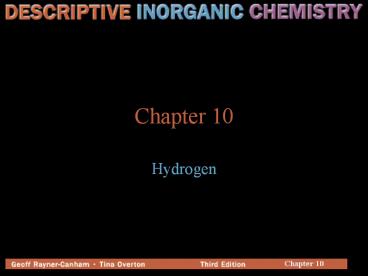Hydrogen - PowerPoint PPT Presentation
Title:
Hydrogen
Description:
All are stable except for tritium. synthesized in the ... enclosed behind bars. gas hydrates. methane. noble gases. Biological Aspects of Hydrogen Bonding ... – PowerPoint PPT presentation
Number of Views:7533
Avg rating:3.0/5.0
Title: Hydrogen
1
Chapter 10
- Hydrogen
2
History
- Discovered about 200 years ago (1766)
Antoine Lavoisier (1743-1794)
Henry Cavendish (1731-1810)
3
History
- In 1931, hydrogen was discovered to have isotopes
vs.
Harold C. Urey (1893-1981)
Frederick Soddy (1877-1956)
Nobel Laureate 1934
Nobel Laureate 1921
4
Isotopes of Hydrogen
- Three common isotopes
- Protium (H)
- common hydrogen
- 99.985 abundant
- Deuterium (D)
- one neutron
- 0.015 abundant
- Tritium (T)
- two neutrons
- 1x10-15 abundant
5
Physical Properties
- Vastly different among the three isotopes
6
Stability
- All are stable except for tritium
- synthesized in the universe and man-made by
neutron bombardment - undergoes radioactive ? decay
7
Nuclear Magnetic Resonance
- Studies nuclear spin
8
Nuclear Magnetic Resonance
- Peaks depend upon the chemical environment
9
Nuclear Magnetic Resonance
- Intensity of the absorption depends upon the
nucleus
10
Magnetic Resonance Imaging
- Measures the 1H nucleus in water
11
Properties of Hydrogen
- Periodic table placement
- reasons to place the element in both Group
1(alkali metals) and Group 17 (halogens)
Argument for Placement Argument Against Placement
Alkali Metal Group forms monopositive ions is not a metal
Alkali Metal Group has a single s electron does not react with water
Halogen Group is a nonmetal rarely forms a mononegative ion
Halogen Group forms a diatomic molecule is comparatively unreactive
12
Properties of Hydrogen
- Colorless, odorless gas
- m.p. -259C
- b.p. -253C
- Relatively non-reactive
- diatomic bond energy of 436 kJ/mol
13
Reactions of Hydrogen with Diatomics
- 2H2(g) O2(g) ? 2H2O(g) (very fast)
- H2(g) F2(g) ? 2HF(g) (very fast)
- 3H2(g) N2(g) ? 2NH3(g) (very slow)
14
Reduction Reactions of Hydrogen
- Acts to reduce many metallic elements
- CuO(s) H2(g) ? Cu(s) H2O(g)
- Can also reduce double and triple bonds with a
catalyst - H2CCH2(g) H2(g) ? H3CCH3(g)
15
Preparation of Dihydrogen
- Reaction of dilute acids on metals
- Zn(s) 2HCl(aq) ? ZnCl2(aq) H2(g)
16
Preparation of Dihydrogen
- Steam reformer process
- CH4(g) H2O(g) ? CO(g) 3H2(g)
- CO(g) H2O(g) ? CO2(g) H2(g)
- K2CO3(aq) CO2(g) H2O(l) ? 2KHCO3(aq)
17
Hydrides
- Binary compounds of hydrogen
- has an intermediate electronegativity
- ionic hydrides
- LiH
- covalent hydrides
- HF
- metallic hydrides
- NiH2
18
Ionic Hydrides
- white solids
- metal cation and hydride ion
- very reactive
- LiH(s) H2O(l) ? LiOH(aq) H2(g)
- reducing agents
- CaH2(s) H2O(l) ? Ca(OH)2(s) H2(g)
19
Covalent Hydrides
- covalently bonds with all nonmetals and weakly
electropositive metals - gases at room temperature
- hydrogen can be
- nearly neutral
- substantially positive
- slightly negative
20
Neutral Covalent Hydrides
- low polarity
- only dispersion forces
- Examples
- PH3
- CH4
- Hexene
- CH4(g) 2O2(g) ? CO2(g) 2H2O(g)
21
Positive Covalent Hydrides
- high melting and boiling points
- protonic bridging
- Examples
- ammonia
- water
- hydrogen fluoride
22
Negative Covalent Hydrides
- Contains hydridic hydrogens
- Very reactive towards oxygen
- Examples
- B2H6
- SiH4
- GeH4
- GeH4(g) 2O2(g) ? GeO2(s) 2H2O(l)
23
Borane Bonding
- possess bridging hydrogens
- hydridic bridges
- very reactive
B2H6
24
Borane Bonding
- Three-center, two-electron bond
- banana bonds
25
Borane Bonding
- MO Picture
26
Borane Bonding
- Other borane structures
27
Metallic Hydrides
- Hydrogen occupies the interstitial spaces
- non-stoichiometric
- TiH1.9
- less densities
- brittle
- lower conductivity
28
Synthesis and Reactions of Metallic Hydrides
- Ti(s) H2(g) heat/pressure ? TiH1.9(s)
- TiH1.9(s) heat ? Ti(s) H2(g)
- applications in hydrogen storage
29
Uses of Metallic Hydrides
- Batteries
- Cathode Ni(OH)2(s) OH-(aq) ? NiO(OH)(s)
H2O(l) e- - Anode Ni-alloy(s) H2O(l) e- ?
Ni-alloyH(s) OH-(aq)
30
Water and Hydrogen Bonding
- Without hydrogen bonding, water would melt at
-100C and boil at -90C - Liquid is denser than the solid
31
Waters Phase Diagram
- Different from a normal phase diagram
Normal
Water
32
Electrical Conductivity in Water
- highest for solutions of H3O and OH-
33
Clathrates
- a substance which is trapped in the crystal
lattice of another substance - from clathratus
- enclosed behind bars
- gas hydrates
- methane
- noble gases
34
Biological Aspects of Hydrogen Bonding
- Hydrogens properties play two key roles to the
existence of life - closeness in electronegativity to carbon
- ability to form hydrogen bonds
35
Reaction Flowchart
- Shows the different types of reactions of a
certain species































